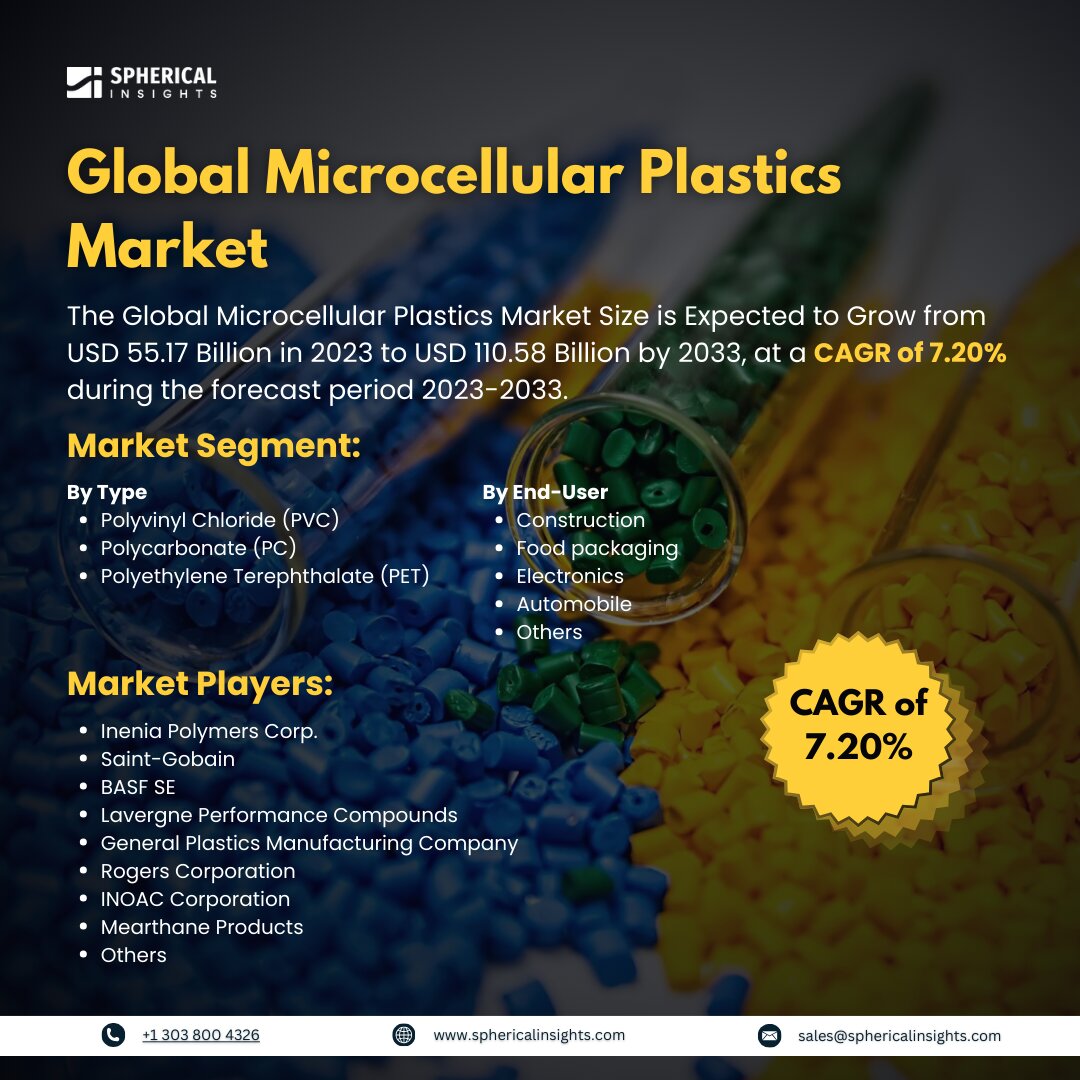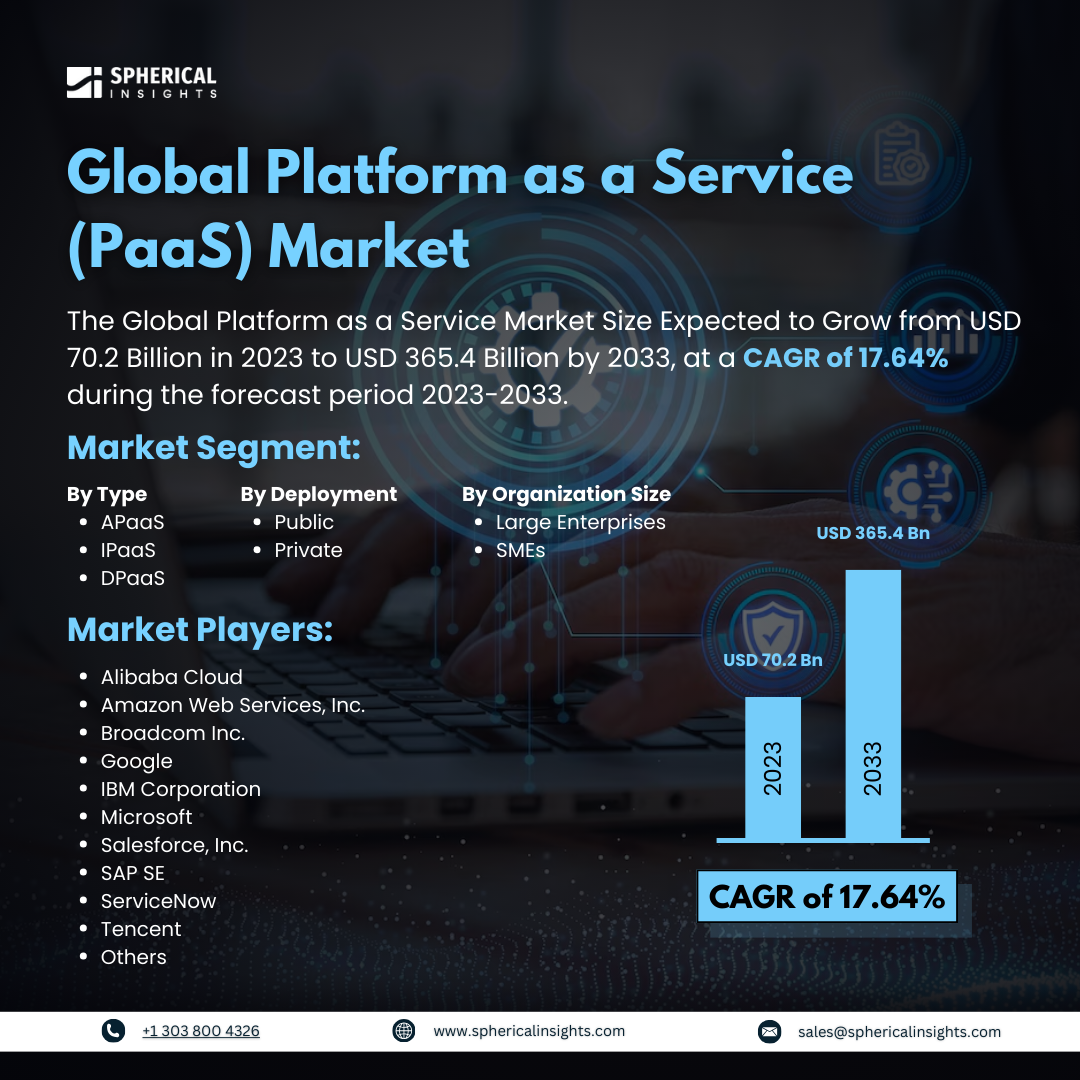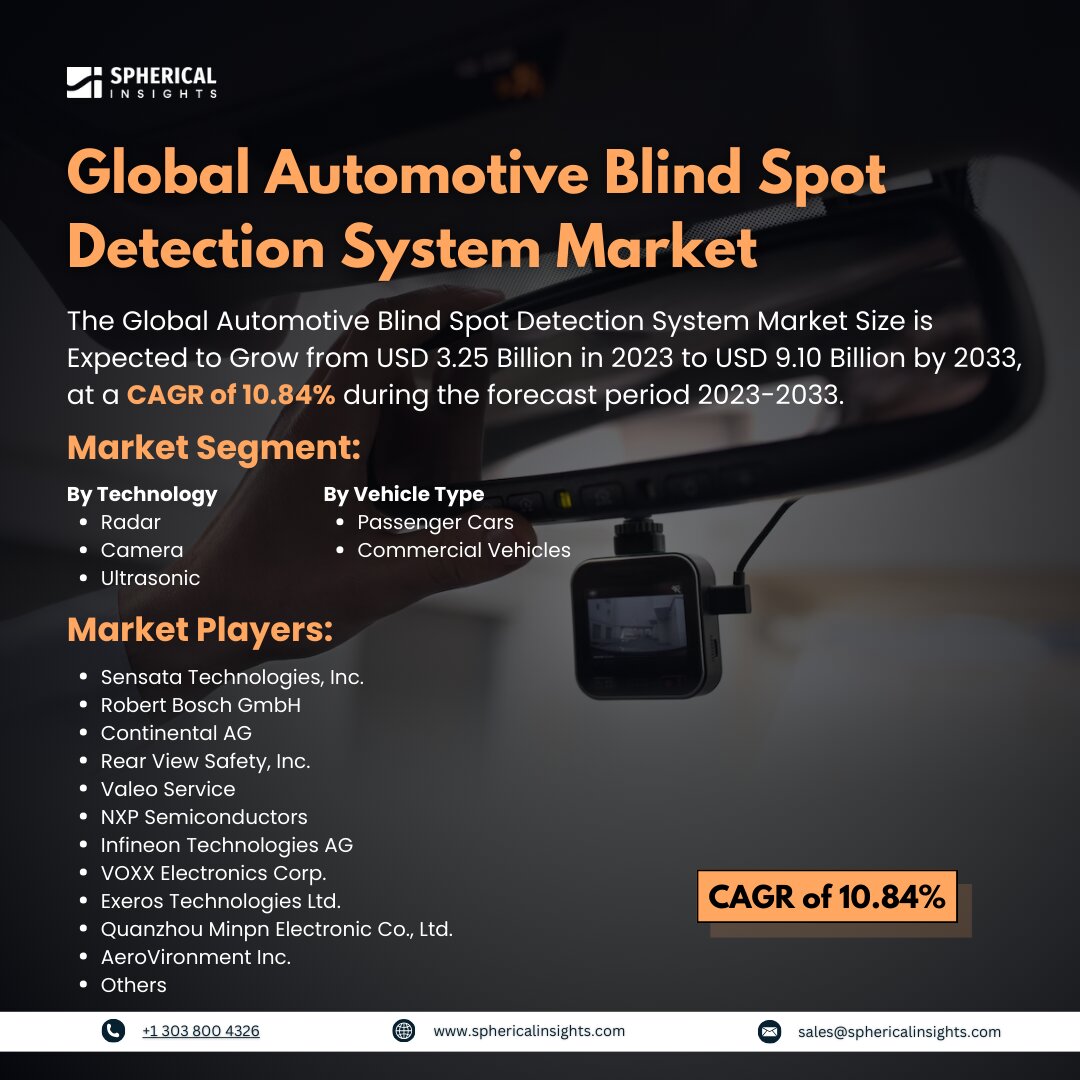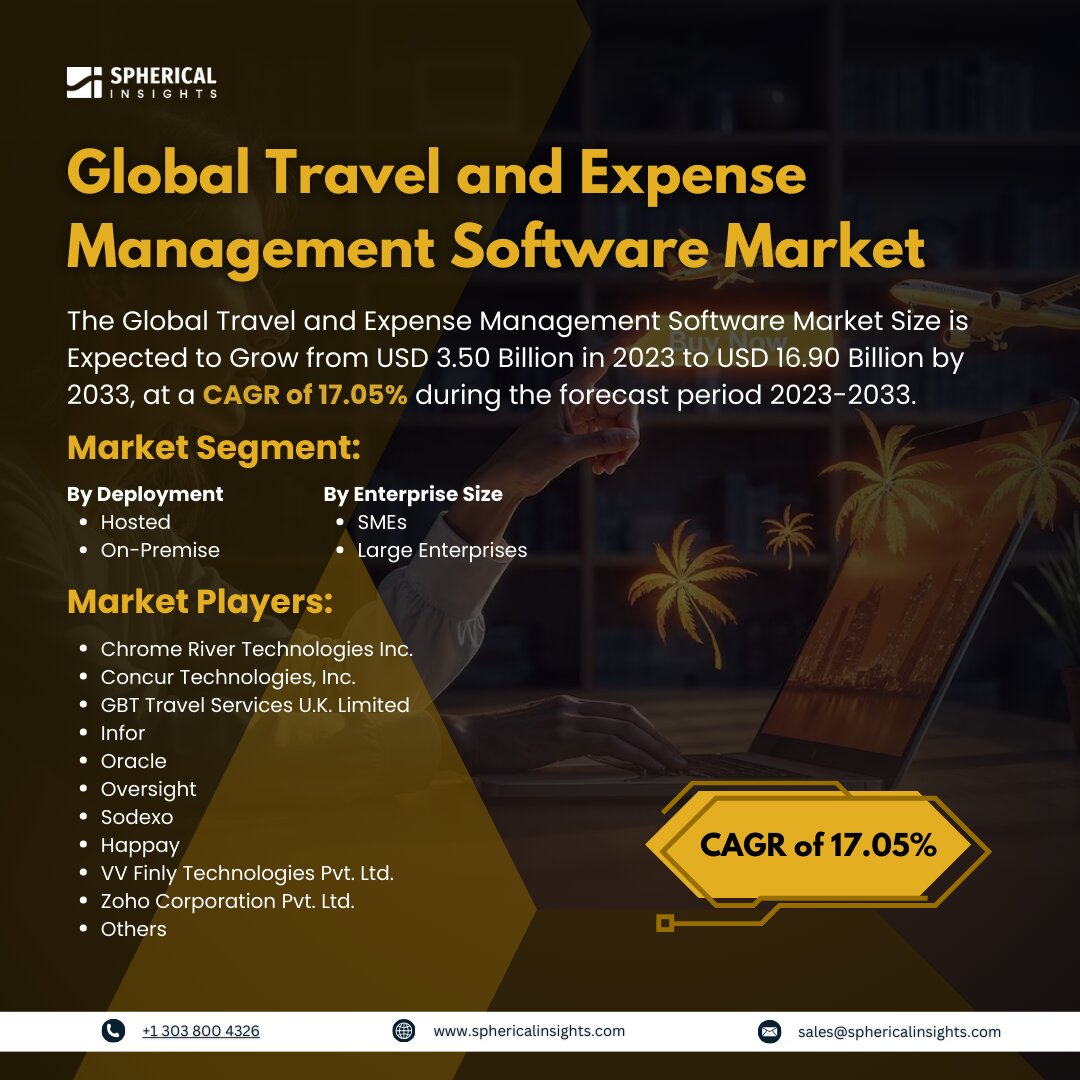Global Microcellular Plastics Market Size to worth USD 110.58 Billion by 2033
According to a research report published by Spherical Insights & Consulting, the Global Microcellular Plastics Market Size is Expected to Grow from USD 55.17 Billion in 2023 to USD 110.58 Billion by 2033, at a CAGR of 7.20% during the forecast period 2023-2033.
Browse key industry insights spread across 210 pages with 110 Market data tables and figures & charts from the report on the Global Microcellular Plastics Market Size, Share, and COVID-19 Impact Analysis, By Type (Polyvinyl Chloride (PVC), Polycarbonate (PC), and Polyethylene Terephthalate (PET)), By End-User (Construction, Food Packaging, Electronics, Automobile, and Others), and By Region (North America, Europe, Asia-Pacific, Latin America, Middle East, and Africa), Analysis and Forecast 2023 – 2033.
The manufacturing, distribution, and use of microcellular plastics thermoplastic polymers with many small bubbles per cubic centimeter are all included in the global microcellular plastics market. Excellent strength-to-weight ratios, durability, impact resistance, thermal stability, and acoustic insulation qualities are what define these plastics. One of the most significant markets for composite materials is the automotive sector. The automotive industry is continuously searching for innovative materials to satisfy fuel efficiency and carbon emission targets while simultaneously reducing vehicle weight. It is anticipated that the automotive industry's increased demand for lightweight materials and the growing focus on fuel efficiency will be the segment's main growth factors. As gasoline prices and driving distance increase, consumers want more miles per gallon and often consider gas economy to be a critical factor when buying a car. However, microcellular plastic, despite its eco-friendly properties, faces high material costs, limited applicability, and limited market availability due to its porous structure and intricate manufacturing process.
The polyvinyl chloride (PVC) segment accounted for the largest share in 2023 and is expected to grow at a significant CAGR during the forecast period.
Based on the type, the microcellular plastics market is classified into polyvinyl chloride (PVC), polycarbonate (PC), and polyethylene terephthalate (PET). Among these, the polyvinyl chloride (PVC) segment accounted for the largest share in 2023 and is expected to grow at a significant CAGR during the forecast period. PVC (polyvinyl chloride), a thermoplastic polymer with exceptional strength, is responsible for this growth. It is the third most-produced synthetic plastic polymer in the world because of its high demand in the end-use sectors of cable insulation, pipes, wires, and medical devices.
The food packaging segment accounted for the highest market share in 2023 and is expected to grow at a significant CAGR during the forecast period.
Based on the end-user, the microcellular plastics market is divided into construction, food packaging, electronics, automobile, and others. Among these, the food packaging segment accounted for the highest share in 2023 and is expected to grow at a significant CAGR during the forecast period. This growth may be explained by the fact that they are recyclable and by the speed at which the industry is developing.
North America is estimated to hold the largest share of the microcellular plastics market over the forecast period.
North America is estimated to hold the largest share of the microcellular plastics market over the forecast period. North America's microcellular plastics market is expected to grow due to industrial recovery, increased building restoration and maintenance expenditure, and automobile manufacturers' presence. Investment in R&D and innovation activities will also boost market growth. The US and Canada are key contributors, with moderate growth expected due to increased food packaging usage and healthcare sector growth.
Asia Pacific is predicted to have the fastest CAGR growth in the microcellular plastics market over the forecast period. Microcellular plastics demand is expected to rise in Asia Pacific countries like the Philippines, Australia, Taiwan, South Korea, China, India, Japan, Thailand, Malaysia, Bangladesh, and Vietnam due to rising automotive vehicle production, strong manufacturing base, cheap labor, and regulatory environment.
Competitive Analysis
Major key players in the microcellular plastics market include Inenia Polymers Corp., Saint-Gobain, BASF SE, Lavergne Performance Compounds, General Plastics Manufacturing Company, Rogers Corporation, INOAC Corporation, Mearthane Products, and Others.
Recent Development
- In January 2025, the new Zetasinter 4L sintering furnace from Nanoe is a complement to their current Zetamix® metal and ceramic filament range. In partnership with the Cerinnov Group, this cutting-edge furnace was created to close the market for medium-sized sinter-based additive manufacturing components.
Key Target Audience
- Market Players
- Investors
- End-users
- Government Authorities
- Consulting And Research Firm
- Venture capitalists
- Value-Added Resellers (VARs)
Market Segment
This study forecasts revenue at global, regional, and country levels from 2023 to 2033. Spherical Insights has segmented the microcellular plastics market based on the below-mentioned segments:
Global Microcellular Plastics Market, By Type
- Polyvinyl Chloride (PVC)
- Polycarbonate (PC)
- Polyethylene Terephthalate (PET)
Global Microcellular Plastics Market, By End-User
- Construction
- Food packaging
- Electronics
- Automobile
- Others
Global Microcellular Plastics Market, By Regional Analysis
- North America
- Europe
- Germany
- UK
- France
- Italy
- Spain
- Russia
- Rest of Europe
- Asia Pacific
- China
- Japan
- India
- South Korea
- Australia
- Rest of Asia Pacific
- South America
- Brazil
- Argentina
- Rest of South America
- Middle East & Africa
- UAE
- Saudi Arabia
- Qatar
- South Africa
- Rest of the Middle East & Africa



